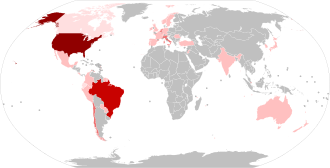SARS-CoV-2 Gamma variant
[4][9] It was first detected by the National Institute of Infectious Diseases (NIID) of Japan, on 6 January 2021 in four people who had arrived in Tokyo having visited Amazonas, Brazil, four days earlier.
Lineage P.2 (B.1.1.28.2, Zeta variant), first detected in October 2020 in the state of Rio de Janeiro, Brazil, only shares one mutation of concern with P.1, which is the E484K.
Although researchers have not identified its precise origin, it was first sequenced in Itirapina, Brazil, and was already circulating in various municipalities in the state of São Paulo of the same country.
[29][30] The branch of this lineage is P.4.1 (VUI-NP13L)—suspected to have arisen in Goiás, Brazil, around June–July 2020— also rapidly spread to the southeast of the country, where for example Taquara had its first genome sequence, and to the northeast of the nation.
[31] On 12 January 2021, the Brazil–United Kingdom CADDE Centre confirmed 13 local cases of lineage P.1 in Manaus, Amazonas state, the largest city of the Amazon rain forest.
[4][89] A study of 180 sequenced Brazilian samples collected in the state of Rio de Janeiro during 2020, identified emergence of the novel lineage P.2 of SARS-CoV-2 (originating from B.1.1.28).
[91] The Centre for Arbovirus Discovery, Diagnosis, Genomics and Epidemiology (CADDE) produced another journal article of samples collected in Manaus between November 2020 and January 2021.
[92][93][94] As part of ongoing research, the variant's capacity to neutralise antibodies has been evaluated by scientists in a published preprint work demonstrating that 8 CoronaVac-immunised persons had a poor blood plasma response against lineage P.1.
[96] In March 2022, the World Health Organization listed the Alpha, Beta and Gamma variants as previously circulating citing lack of any detected cases in the prior weeks and months.


Legend:
